[English] 日本語
 Yorodumi
Yorodumi- PDB-8glh: Crystal Structure of Human CD1b in Complex with Endogenous PC C40:5 -
+ Open data
Open data
- Basic information
Basic information
| Entry | Database: PDB / ID: 8glh | ||||||
|---|---|---|---|---|---|---|---|
| Title | Crystal Structure of Human CD1b in Complex with Endogenous PC C40:5 | ||||||
 Components Components |
| ||||||
 Keywords Keywords | IMMUNE SYSTEM / Antigen Presentation / Lipid / CD1b / phospholipid | ||||||
| Function / homology |  Function and homology information Function and homology informationexogenous lipid antigen binding / antigen processing and presentation, endogenous lipid antigen via MHC class Ib / lipopeptide binding / endogenous lipid antigen binding / antigen processing and presentation, exogenous lipid antigen via MHC class Ib / negative regulation of receptor binding / early endosome lumen / Nef mediated downregulation of MHC class I complex cell surface expression / DAP12 interactions / transferrin transport ...exogenous lipid antigen binding / antigen processing and presentation, endogenous lipid antigen via MHC class Ib / lipopeptide binding / endogenous lipid antigen binding / antigen processing and presentation, exogenous lipid antigen via MHC class Ib / negative regulation of receptor binding / early endosome lumen / Nef mediated downregulation of MHC class I complex cell surface expression / DAP12 interactions / transferrin transport / cellular response to iron ion / Endosomal/Vacuolar pathway / Antigen Presentation: Folding, assembly and peptide loading of class I MHC / peptide antigen assembly with MHC class II protein complex / cellular response to iron(III) ion / MHC class II protein complex / negative regulation of forebrain neuron differentiation / antigen processing and presentation of exogenous protein antigen via MHC class Ib, TAP-dependent / ER to Golgi transport vesicle membrane / peptide antigen assembly with MHC class I protein complex / regulation of iron ion transport / regulation of erythrocyte differentiation / HFE-transferrin receptor complex / response to molecule of bacterial origin / MHC class I peptide loading complex / T cell mediated cytotoxicity / positive regulation of T cell cytokine production / antigen processing and presentation of endogenous peptide antigen via MHC class I / antigen processing and presentation of exogenous peptide antigen via MHC class II / positive regulation of immune response / MHC class I protein complex / positive regulation of T cell activation / peptide antigen binding / positive regulation of receptor-mediated endocytosis / negative regulation of neurogenesis / cellular response to nicotine / positive regulation of T cell mediated cytotoxicity / multicellular organismal-level iron ion homeostasis / specific granule lumen / phagocytic vesicle membrane / recycling endosome membrane / Interferon gamma signaling / Immunoregulatory interactions between a Lymphoid and a non-Lymphoid cell / negative regulation of epithelial cell proliferation / MHC class II protein complex binding / Modulation by Mtb of host immune system / late endosome membrane / sensory perception of smell / positive regulation of cellular senescence / tertiary granule lumen / DAP12 signaling / T cell differentiation in thymus / negative regulation of neuron projection development / ER-Phagosome pathway / protein refolding / early endosome membrane / protein homotetramerization / amyloid fibril formation / adaptive immune response / intracellular iron ion homeostasis / learning or memory / endosome membrane / immune response / endoplasmic reticulum lumen / Amyloid fiber formation / Golgi membrane / lysosomal membrane / external side of plasma membrane / focal adhesion / intracellular membrane-bounded organelle / Neutrophil degranulation / SARS-CoV-2 activates/modulates innate and adaptive immune responses / structural molecule activity / cell surface / endoplasmic reticulum / Golgi apparatus / protein homodimerization activity / extracellular space / extracellular exosome / extracellular region / identical protein binding / membrane / plasma membrane / cytosol Similarity search - Function | ||||||
| Biological species |  Homo sapiens (human) Homo sapiens (human) | ||||||
| Method |  X-RAY DIFFRACTION / X-RAY DIFFRACTION /  SYNCHROTRON / SYNCHROTRON /  MOLECULAR REPLACEMENT / Resolution: 1.83 Å MOLECULAR REPLACEMENT / Resolution: 1.83 Å | ||||||
 Authors Authors | Farquhar, R. / Rossjohn, J. / Shahine, A. | ||||||
| Funding support |  Australia, 1items Australia, 1items
| ||||||
 Citation Citation |  Journal: Cell / Year: 2023 Journal: Cell / Year: 2023Title: CD1 lipidomes reveal lipid-binding motifs and size-based antigen-display mechanisms. Authors: Huang, S. / Shahine, A. / Cheng, T.Y. / Chen, Y.L. / Ng, S.W. / Balaji, G.R. / Farquhar, R. / Gras, S. / Hardman, C.S. / Altman, J.D. / Tahiri, N. / Minnaard, A.J. / Ogg, G.S. / Mayfield, J. ...Authors: Huang, S. / Shahine, A. / Cheng, T.Y. / Chen, Y.L. / Ng, S.W. / Balaji, G.R. / Farquhar, R. / Gras, S. / Hardman, C.S. / Altman, J.D. / Tahiri, N. / Minnaard, A.J. / Ogg, G.S. / Mayfield, J.A. / Rossjohn, J. / Moody, D.B. | ||||||
| History |
|
- Structure visualization
Structure visualization
| Structure viewer | Molecule:  Molmil Molmil Jmol/JSmol Jmol/JSmol |
|---|
- Downloads & links
Downloads & links
- Download
Download
| PDBx/mmCIF format |  8glh.cif.gz 8glh.cif.gz | 187.2 KB | Display |  PDBx/mmCIF format PDBx/mmCIF format |
|---|---|---|---|---|
| PDB format |  pdb8glh.ent.gz pdb8glh.ent.gz | 142.5 KB | Display |  PDB format PDB format |
| PDBx/mmJSON format |  8glh.json.gz 8glh.json.gz | Tree view |  PDBx/mmJSON format PDBx/mmJSON format | |
| Others |  Other downloads Other downloads |
-Validation report
| Summary document |  8glh_validation.pdf.gz 8glh_validation.pdf.gz | 1.6 MB | Display |  wwPDB validaton report wwPDB validaton report |
|---|---|---|---|---|
| Full document |  8glh_full_validation.pdf.gz 8glh_full_validation.pdf.gz | 1.6 MB | Display | |
| Data in XML |  8glh_validation.xml.gz 8glh_validation.xml.gz | 22.6 KB | Display | |
| Data in CIF |  8glh_validation.cif.gz 8glh_validation.cif.gz | 32.9 KB | Display | |
| Arichive directory |  https://data.pdbj.org/pub/pdb/validation_reports/gl/8glh https://data.pdbj.org/pub/pdb/validation_reports/gl/8glh ftp://data.pdbj.org/pub/pdb/validation_reports/gl/8glh ftp://data.pdbj.org/pub/pdb/validation_reports/gl/8glh | HTTPS FTP |
-Related structure data
| Related structure data |  8gleC  8glfC  8glgC 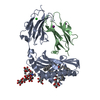 8gliC 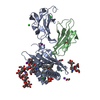 6d64S S: Starting model for refinement C: citing same article ( |
|---|---|
| Similar structure data | Similarity search - Function & homology  F&H Search F&H Search |
- Links
Links
- Assembly
Assembly
| Deposited unit | 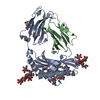
| ||||||||
|---|---|---|---|---|---|---|---|---|---|
| 1 |
| ||||||||
| Unit cell |
|
- Components
Components
-Protein , 2 types, 2 molecules AB
| #1: Protein | Mass: 33530.691 Da / Num. of mol.: 1 Source method: isolated from a genetically manipulated source Source: (gene. exp.)  Homo sapiens (human) / Gene: CD1B / Plasmid: pFastBac / Cell line (production host): Hi5 / Production host: Homo sapiens (human) / Gene: CD1B / Plasmid: pFastBac / Cell line (production host): Hi5 / Production host:  Trichoplusia ni (cabbage looper) / References: UniProt: P29016 Trichoplusia ni (cabbage looper) / References: UniProt: P29016 |
|---|---|
| #2: Protein | Mass: 11974.456 Da / Num. of mol.: 1 Source method: isolated from a genetically manipulated source Source: (gene. exp.)  Homo sapiens (human) / Gene: B2M, CDABP0092, HDCMA22P / Plasmid: pFastBac / Cell line (production host): Hi5 / Production host: Homo sapiens (human) / Gene: B2M, CDABP0092, HDCMA22P / Plasmid: pFastBac / Cell line (production host): Hi5 / Production host:  Trichoplusia ni (cabbage looper) / References: UniProt: P61769 Trichoplusia ni (cabbage looper) / References: UniProt: P61769 |
-Sugars , 2 types, 2 molecules
| #3: Polysaccharide | alpha-D-mannopyranose-(1-3)-[alpha-D-mannopyranose-(1-6)]beta-D-mannopyranose-(1-4)-2-acetamido-2- ...alpha-D-mannopyranose-(1-3)-[alpha-D-mannopyranose-(1-6)]beta-D-mannopyranose-(1-4)-2-acetamido-2-deoxy-beta-D-glucopyranose-(1-4)-[alpha-L-fucopyranose-(1-3)][alpha-L-fucopyranose-(1-6)]2-acetamido-2-deoxy-beta-D-glucopyranose Source method: isolated from a genetically manipulated source |
|---|---|
| #4: Polysaccharide | beta-D-mannopyranose-(1-4)-2-acetamido-2-deoxy-beta-D-glucopyranose-(1-4)-[alpha-L-fucopyranose-(1- ...beta-D-mannopyranose-(1-4)-2-acetamido-2-deoxy-beta-D-glucopyranose-(1-4)-[alpha-L-fucopyranose-(1-3)][alpha-L-fucopyranose-(1-6)]2-acetamido-2-deoxy-beta-D-glucopyranose Type: oligosaccharide / Mass: 878.823 Da / Num. of mol.: 1 Source method: isolated from a genetically manipulated source |
-Non-polymers , 6 types, 412 molecules 

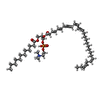
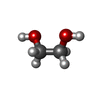







| #5: Chemical | | #6: Chemical | ChemComp-3IV / ( | #7: Chemical | ChemComp-3IY / [( | #8: Chemical | ChemComp-EDO / #9: Chemical | ChemComp-NA / | #10: Water | ChemComp-HOH / | |
|---|
-Details
| Has ligand of interest | Y |
|---|---|
| Has protein modification | Y |
-Experimental details
-Experiment
| Experiment | Method:  X-RAY DIFFRACTION / Number of used crystals: 1 X-RAY DIFFRACTION / Number of used crystals: 1 |
|---|
- Sample preparation
Sample preparation
| Crystal | Density Matthews: 2.22 Å3/Da / Density % sol: 44.69 % |
|---|---|
| Crystal grow | Temperature: 293 K / Method: vapor diffusion, hanging drop Details: 24% PEG3350, 0.2 M sodium iodide, 2% ethylene glycol |
-Data collection
| Diffraction | Mean temperature: 100 K / Serial crystal experiment: N |
|---|---|
| Diffraction source | Source:  SYNCHROTRON / Site: SYNCHROTRON / Site:  Australian Synchrotron Australian Synchrotron  / Beamline: MX1 / Wavelength: 0.9537 Å / Beamline: MX1 / Wavelength: 0.9537 Å |
| Detector | Type: DECTRIS EIGER X 9M / Detector: PIXEL / Date: May 10, 2019 |
| Radiation | Protocol: SINGLE WAVELENGTH / Monochromatic (M) / Laue (L): M / Scattering type: x-ray |
| Radiation wavelength | Wavelength: 0.9537 Å / Relative weight: 1 |
| Reflection | Resolution: 1.83→41.13 Å / Num. obs: 36495 / % possible obs: 99.7 % / Redundancy: 7.3 % / CC1/2: 0.99 / Rpim(I) all: 0.037 / Net I/σ(I): 19.5 |
| Reflection shell | Resolution: 1.83→1.87 Å / Redundancy: 7.1 % / Mean I/σ(I) obs: 2.3 / Num. unique obs: 2143 / CC1/2: 0.78 / Rpim(I) all: 0.469 / % possible all: 95.7 |
- Processing
Processing
| Software |
| |||||||||||||||||||||||||||||||||||||||||||||||||||||||||||||||||||||||||||||||||||||||||||||||||||||||||||||||||||||||||||||
|---|---|---|---|---|---|---|---|---|---|---|---|---|---|---|---|---|---|---|---|---|---|---|---|---|---|---|---|---|---|---|---|---|---|---|---|---|---|---|---|---|---|---|---|---|---|---|---|---|---|---|---|---|---|---|---|---|---|---|---|---|---|---|---|---|---|---|---|---|---|---|---|---|---|---|---|---|---|---|---|---|---|---|---|---|---|---|---|---|---|---|---|---|---|---|---|---|---|---|---|---|---|---|---|---|---|---|---|---|---|---|---|---|---|---|---|---|---|---|---|---|---|---|---|---|---|---|
| Refinement | Method to determine structure:  MOLECULAR REPLACEMENT MOLECULAR REPLACEMENTStarting model: PDB entry 6D64 Resolution: 1.83→41.13 Å / SU ML: 0.23 / Cross valid method: THROUGHOUT / σ(F): 1.34 / Phase error: 21.13 / Stereochemistry target values: ML
| |||||||||||||||||||||||||||||||||||||||||||||||||||||||||||||||||||||||||||||||||||||||||||||||||||||||||||||||||||||||||||||
| Solvent computation | Shrinkage radii: 0.9 Å / VDW probe radii: 1.11 Å / Solvent model: FLAT BULK SOLVENT MODEL | |||||||||||||||||||||||||||||||||||||||||||||||||||||||||||||||||||||||||||||||||||||||||||||||||||||||||||||||||||||||||||||
| Displacement parameters | Biso mean: 30.57 Å2 | |||||||||||||||||||||||||||||||||||||||||||||||||||||||||||||||||||||||||||||||||||||||||||||||||||||||||||||||||||||||||||||
| Refinement step | Cycle: LAST / Resolution: 1.83→41.13 Å
| |||||||||||||||||||||||||||||||||||||||||||||||||||||||||||||||||||||||||||||||||||||||||||||||||||||||||||||||||||||||||||||
| LS refinement shell |
| |||||||||||||||||||||||||||||||||||||||||||||||||||||||||||||||||||||||||||||||||||||||||||||||||||||||||||||||||||||||||||||
| Refinement TLS params. | Method: refined / Refine-ID: X-RAY DIFFRACTION
| |||||||||||||||||||||||||||||||||||||||||||||||||||||||||||||||||||||||||||||||||||||||||||||||||||||||||||||||||||||||||||||
| Refinement TLS group |
|
 Movie
Movie Controller
Controller


 PDBj
PDBj






